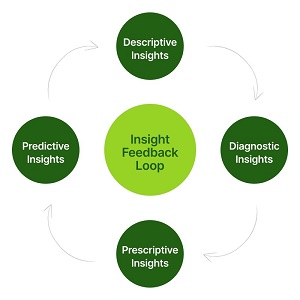
Beyond Spreadsheets: How Data-Driven Organizations Outperform the Rest
These four best practices can help you successfully build a data-driven organization.
- By Dan LeBlanc
- September 20, 2023
In today’s data-rich world, it’s more important than ever to have a data-driven organization to inform decision-making, improve processes, and drive business outcomes. When an organization is truly data-driven, employees across all functions and levels understand the importance of data and how to leverage it to drive the best possible results.
Data-driven organizations succeed: a recent study by Harvard Business Review for Google Cloud regarding whether organizations took a data-driven approach during COVID-19 found that “data and AI leaders outperformed their peers across a range of key business metrics, such as operational efficiency (81% vs. 58%), revenues (77% vs. 61%), customer loyalty and retention (77% vs. 45%), employee satisfaction (68% vs. 39%), and IT cost predictability (59% vs. 44%).” That’s a strong outcome for data-driven organizations.
Building and developing a data-driven organization requires commitment from leaders, investment in training and technology, and a willingness to experiment and learn. However, the benefits are clear, and organizations that commit to becoming data-driven will be better positioned to succeed and outperform their competitors.
Here are four keys I’ve learned over my career that can help you successfully build a data-driven organization.
Without Appropriate Data Infrastructure, Your Organization Can Never Be Data-Driven
The tools will vary and evolve, but without a data system or a set of procedures to centralize and analyze data, your organization cannot leverage its data to make decisions.
Most often, an organization will start organizing data in spreadsheets for simple reporting. When spreadsheets become unwieldy, they progress to centralizing data in a database, where they can automate some data movement and may invest in a simpler transformation layer to run analytics.
In the end, though, that’s not enough. Your organization will need to load its data via ELT in a data warehouse, which will enable you to centralize virtually limitless data and, with the right investment, transform it into an omnichannel data model. With this infrastructure in place, you can run deep analytics and automate tailored reporting for every role, connect your data warehouse to their preferred BI tools, and run a composable CDP for highly targeted marketing.
The Data Infrastructure Enables Insights that Will Drive Growth and Keep Your Business Healthy
The infrastructure centralizes all business data, powering reporting and analytics, enabling your teams to uncover insights about their business. Fundamentally, to be successful your organization will need to uncover and set processes around four broad categories of insights: descriptive insights (what happened), diagnostic insights (why did it happen), prescriptive insights (what actions to take), and predictive insights (what will happen next).

When optimized, these four insight categories should feed into one another, creating a virtuous cycle. If your enterprise can focus on each category, you will be able to fill in reporting holes, identify decisions that may have negatively impacted performance, and avoid making similar decisions in the future.
Few organizations will be equipped to uncover all categories of insights from the very beginning. This is to be expected. It is simply the nature of complicated and growing businesses. However, to leverage the infrastructure and uncover necessary insights, your organization must create new roles, invest in training, or seek funding to fill in financial gaps.
Without Strong Data Governance, Your Organization Will Not Develop a Coherent Data-Driven Culture
Although there is no single, formalized definition for data governance, we consider it at the highest level to be the standardization of data definitions, descriptions, processes, and management.
Data definitions are the sine qua non of data governance. Formalized organizational definitions of KPIs and metrics are fundamental for a strong and aligned data culture. For instance, an online sale could be defined and counted at the time it was ordered (i.e., demand revenue) or at the time it was shipped (i.e., booked revenue). Having common definitions of events creates a single version of the truth for decision-making; using different definitions may result in different numbers, disagreements, and a lack of clarity, as well as suboptimal forecasting, decisions, and results.
Data description -- that is, labeling data with metadata to describe it -- is a second essential aspect of governance and is crucial for your AI and ML systems to perform at their best. AI systems may not be able to provide decision support on unlabeled data because they function best with clearly labeled data.
Finally, governance includes data processes and change management. Your organization must, for example, define how it will implement a new sales channel and ensure that changes in data sources and formats do not break your reporting.
A Data-Oriented Company Culture Makes Everything Else Possible
Creating a data-driven culture must start at the executive level to drive the understanding that data is central to the operations and success of your organization, as well as to decision-making at every level. It begins with communicating the importance of data, making it a corporate initiative. From there must follow implementing the data infrastructure and analytics tools that enable every role to get the data needed to drive evidenced-based decision-making.
There is no right or wrong organizational structure to create a data-driven culture. Still, creating and assigning roles and responsibilities that will work for your organization, and then staffing and training accordingly, are essential. You may choose to train most of your staff to understand and support analytics, or you may rely on a few for performing analytics while conveying across your organization the overall importance and requirements of using data and analytics to drive desired results.
For most organizations, it’s now imperative to establish a data-driven organization, which can optimize decision-making and position them competitively for success. When every penny counts, every decision matters -- and every decision must be backed by data.
About the Author
Daasity CEO and co-founder Dan LeBlanc is an analytics, customer experience, and business technology expert who is passionate about helping consumer brands achieve their goals through more informed insights. Before founding Daasity, he held senior executive roles with companies such as Provide Commerce, Encore Capital Group, and Groundswell Equity. In his spare time, you can find Dan outdoors enjoying the San Diego weather or visiting one of the city's many great craft breweries.